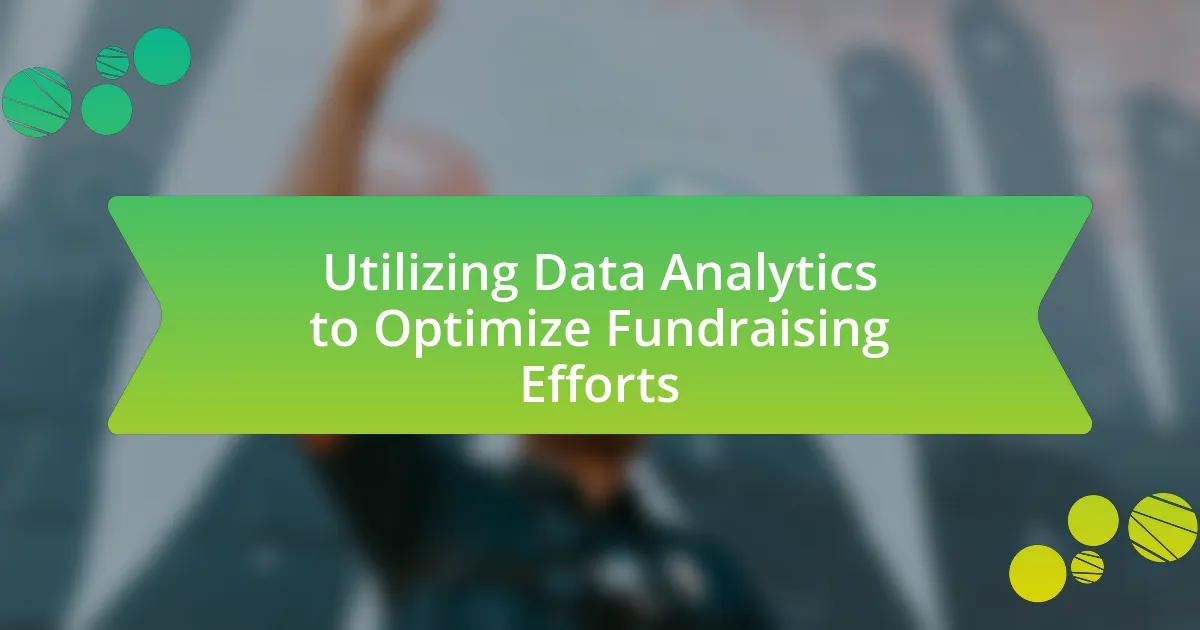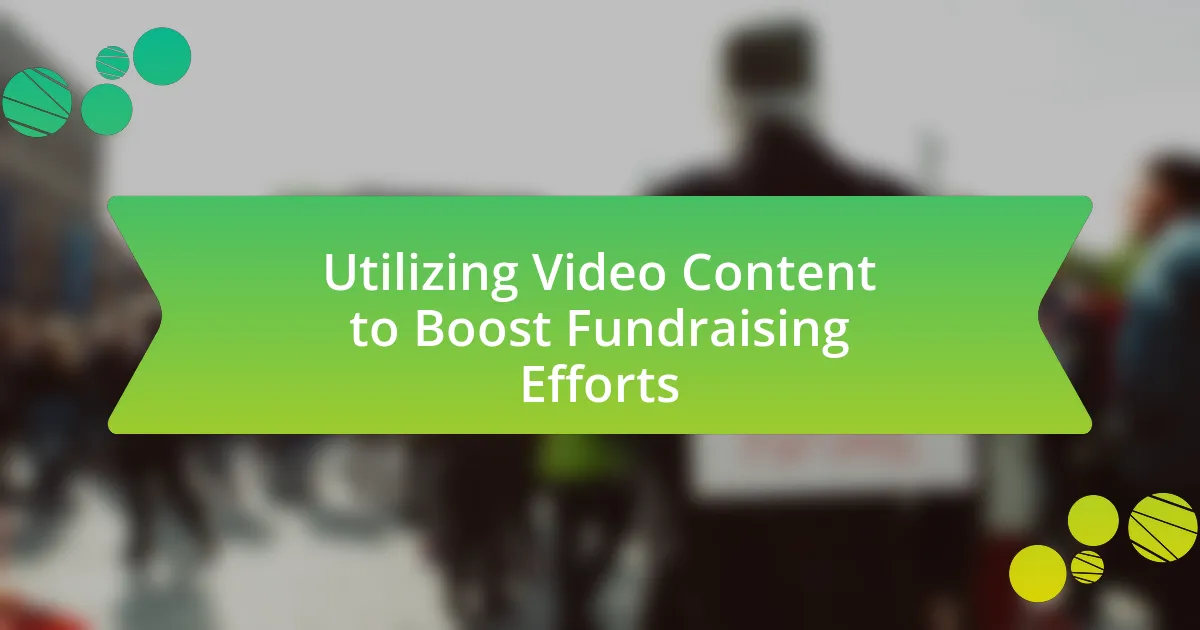Crowdfunding platforms for political donations are online services that enable individuals to contribute funds to political campaigns or causes, democratizing the fundraising process by allowing small donations from a large number of people. These platforms differ from traditional donation methods by increasing accessibility and fostering grassroots support, as evidenced by significant contributions from small donors in recent elections. Key features such as user-friendly interfaces, social sharing capabilities, and real-time updates enhance donor engagement and transparency. The growing popularity of crowdfunding in political fundraising is driven by demands for accountability and community involvement, with demographic trends indicating that younger voters are more likely to engage with these platforms. However, challenges such as regulatory compliance and transparency issues remain critical considerations for campaigns utilizing crowdfunding.
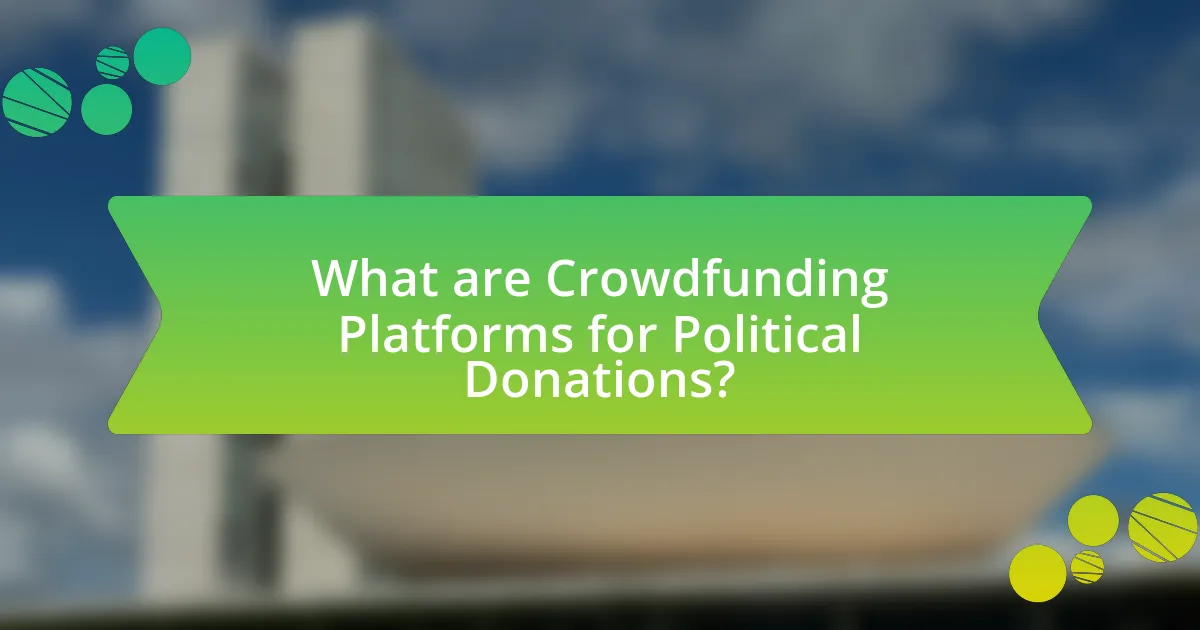
What are Crowdfunding Platforms for Political Donations?
Crowdfunding platforms for political donations are online services that enable individuals to contribute funds to political campaigns or causes. These platforms facilitate the collection of small donations from a large number of people, often leveraging social media and digital marketing to reach potential donors. For instance, platforms like Kickstarter and GoFundMe have been adapted for political purposes, allowing candidates to raise money directly from supporters. According to a report by the Pew Research Center, over 30% of Americans have donated to a political campaign online, highlighting the growing significance of these platforms in modern political fundraising.
How do crowdfunding platforms differ from traditional political donation methods?
Crowdfunding platforms differ from traditional political donation methods primarily in their accessibility and engagement. Crowdfunding allows a broader range of individuals to contribute smaller amounts, democratizing the fundraising process, whereas traditional methods often rely on larger donations from a limited number of wealthy donors or organizations. For instance, in the 2020 U.S. election cycle, candidates who utilized crowdfunding platforms raised significant portions of their funds from small donors, with over 60% of contributions coming from individuals giving less than $200, according to the Federal Election Commission. This shift not only increases the number of contributors but also fosters a sense of community and grassroots support, contrasting with the more transactional nature of traditional donations.
What are the key features of crowdfunding platforms?
Crowdfunding platforms primarily feature user-friendly interfaces, diverse funding options, and social sharing capabilities. User-friendly interfaces allow creators to easily set up campaigns, while diverse funding options, such as rewards-based, equity-based, and donation-based models, cater to various project types. Social sharing capabilities enhance visibility and engagement, enabling users to promote their campaigns across social media channels. According to a report by Statista, the global crowdfunding market was valued at approximately $13.9 billion in 2021, highlighting the significance of these features in attracting backers and facilitating successful fundraising efforts.
How do these features enhance donor engagement?
Crowdfunding platforms enhance donor engagement by providing interactive features that foster community involvement and transparency. These platforms often include real-time updates, allowing donors to see the impact of their contributions immediately, which increases their emotional connection to the cause. Additionally, features such as social sharing options enable donors to promote campaigns within their networks, amplifying outreach and encouraging peer-to-peer engagement. Research indicates that campaigns with interactive elements can raise up to 50% more funds than those without, demonstrating the effectiveness of these features in driving donor participation and commitment.
Why are crowdfunding platforms gaining popularity in political fundraising?
Crowdfunding platforms are gaining popularity in political fundraising due to their ability to democratize the donation process and engage a broader base of supporters. These platforms allow candidates to reach potential donors directly, bypassing traditional fundraising barriers such as high entry costs and exclusive donor networks. For instance, in the 2020 U.S. elections, candidates like Bernie Sanders and Elizabeth Warren successfully utilized crowdfunding to raise millions from small donors, demonstrating the effectiveness of this approach. Additionally, the transparency and immediacy of online crowdfunding campaigns resonate with voters, fostering a sense of community and shared purpose.
What trends are driving the shift towards crowdfunding in politics?
The shift towards crowdfunding in politics is primarily driven by the increasing demand for transparency and grassroots engagement in political funding. As traditional campaign financing faces scrutiny for lack of accountability, crowdfunding offers a more open and participatory alternative, allowing candidates to connect directly with supporters. According to a 2020 study by the Pew Research Center, 43% of Americans believe that crowdfunding can help reduce the influence of large donors in politics, highlighting a growing preference for small, individual contributions over corporate funding. Additionally, the rise of digital platforms has made it easier for candidates to reach potential donors, facilitating a more democratized fundraising process.
How do demographics influence the use of crowdfunding for political donations?
Demographics significantly influence the use of crowdfunding for political donations by affecting the motivations, engagement levels, and financial contributions of different groups. For instance, younger individuals, particularly millennials and Gen Z, are more likely to utilize online crowdfunding platforms due to their familiarity with digital technology and social media, which facilitates sharing and mobilizing support. According to a 2020 study by the Pew Research Center, 50% of younger adults reported using crowdfunding for political causes, compared to only 20% of older adults. Additionally, income levels impact participation; individuals from higher-income brackets tend to contribute larger amounts, while those from lower-income brackets may engage more frequently but with smaller donations. This demographic variation shapes the overall funding landscape, as campaigns targeting younger voters or lower-income communities may adopt different strategies to maximize their crowdfunding efforts.
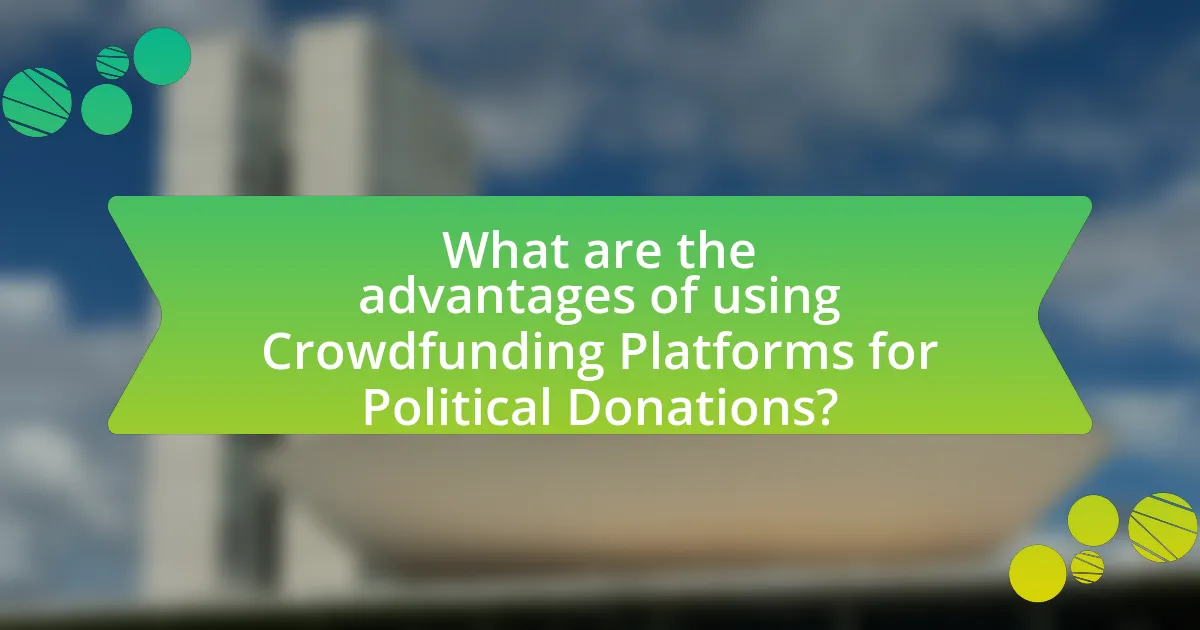
What are the advantages of using Crowdfunding Platforms for Political Donations?
Crowdfunding platforms offer several advantages for political donations, including increased accessibility, broader reach, and enhanced transparency. These platforms enable candidates to tap into a larger pool of potential donors, allowing individuals who may not have been able to contribute through traditional means to participate in the political process. For instance, in the 2020 U.S. elections, candidates who utilized crowdfunding raised significant amounts from small donors, demonstrating the effectiveness of this approach. Additionally, crowdfunding platforms often provide real-time tracking of donations, which enhances transparency and builds trust among supporters. This transparency can lead to increased donor engagement and loyalty, as contributors can see the impact of their donations.
How do crowdfunding platforms increase accessibility for donors?
Crowdfunding platforms increase accessibility for donors by providing a user-friendly online environment that allows individuals to contribute to various causes with minimal barriers. These platforms typically require only an internet connection and a payment method, enabling a broader demographic to participate in funding initiatives. For instance, platforms like Kickstarter and GoFundMe have democratized the donation process, allowing people from diverse backgrounds to support projects they care about, regardless of their geographical location. This accessibility is further enhanced by features such as mobile compatibility, social media integration, and transparent funding goals, which collectively facilitate easier engagement and encourage more frequent donations.
What role does technology play in facilitating donations?
Technology plays a crucial role in facilitating donations by providing platforms that streamline the donation process and enhance accessibility for donors. Crowdfunding platforms, for instance, enable individuals and organizations to raise funds quickly and efficiently by connecting them directly with potential donors through user-friendly interfaces. According to a report by the Pew Research Center, 22% of American adults have donated to a crowdfunding campaign, highlighting the effectiveness of these digital tools in mobilizing financial support. Additionally, technology allows for real-time tracking of donations, automated payment processing, and social sharing capabilities, which further increase engagement and transparency in the donation process.
How do crowdfunding platforms empower grassroots movements?
Crowdfunding platforms empower grassroots movements by providing accessible funding sources that enable individuals and small organizations to raise capital for their initiatives. These platforms democratize fundraising, allowing anyone with a compelling idea to reach a wide audience without relying on traditional financial institutions or large donors. For instance, in 2020, the crowdfunding platform GoFundMe reported that over $9 billion had been raised for various causes, illustrating the significant impact these platforms have on mobilizing community support and resources. This accessibility fosters greater participation in political and social causes, amplifying voices that might otherwise go unheard.
What are the potential challenges associated with crowdfunding for political donations?
Crowdfunding for political donations faces several potential challenges, including regulatory compliance, transparency issues, and donor fatigue. Regulatory compliance is critical, as political crowdfunding must adhere to campaign finance laws, which can vary significantly by jurisdiction and may impose limits on donation amounts or require detailed reporting. Transparency issues arise when donors are not fully aware of how their contributions will be used, leading to mistrust and potential backlash against candidates. Additionally, donor fatigue can occur when individuals feel overwhelmed by frequent requests for contributions, which may diminish their willingness to support candidates over time. These challenges can hinder the effectiveness of crowdfunding as a viable method for political fundraising.
How can transparency issues affect donor trust?
Transparency issues can significantly undermine donor trust by creating doubts about the integrity and accountability of the crowdfunding platform. When donors perceive a lack of transparency regarding how their contributions are utilized, they may question the legitimacy of the platform and the effectiveness of the campaigns. Research indicates that 70% of donors are more likely to contribute to organizations that demonstrate clear financial reporting and transparency (Source: Nonprofit Quarterly, 2020). This statistic highlights that transparency is not just a preference but a critical factor influencing donor behavior. Therefore, transparency issues can lead to decreased donor engagement and financial support, ultimately jeopardizing the success of political donations through crowdfunding platforms.
What regulatory hurdles do crowdfunding platforms face?
Crowdfunding platforms face significant regulatory hurdles primarily related to compliance with securities laws. These platforms must navigate complex regulations set by entities such as the Securities and Exchange Commission (SEC) in the United States, which require that offerings comply with registration or exemption provisions. For instance, under the JOBS Act, crowdfunding platforms can facilitate investments in startups, but they must adhere to limits on the amount individuals can invest based on their income and net worth, which complicates the fundraising process. Additionally, platforms must ensure proper disclosures to investors, which can be burdensome and may deter potential backers. These regulatory requirements are designed to protect investors but can limit the operational flexibility of crowdfunding platforms.
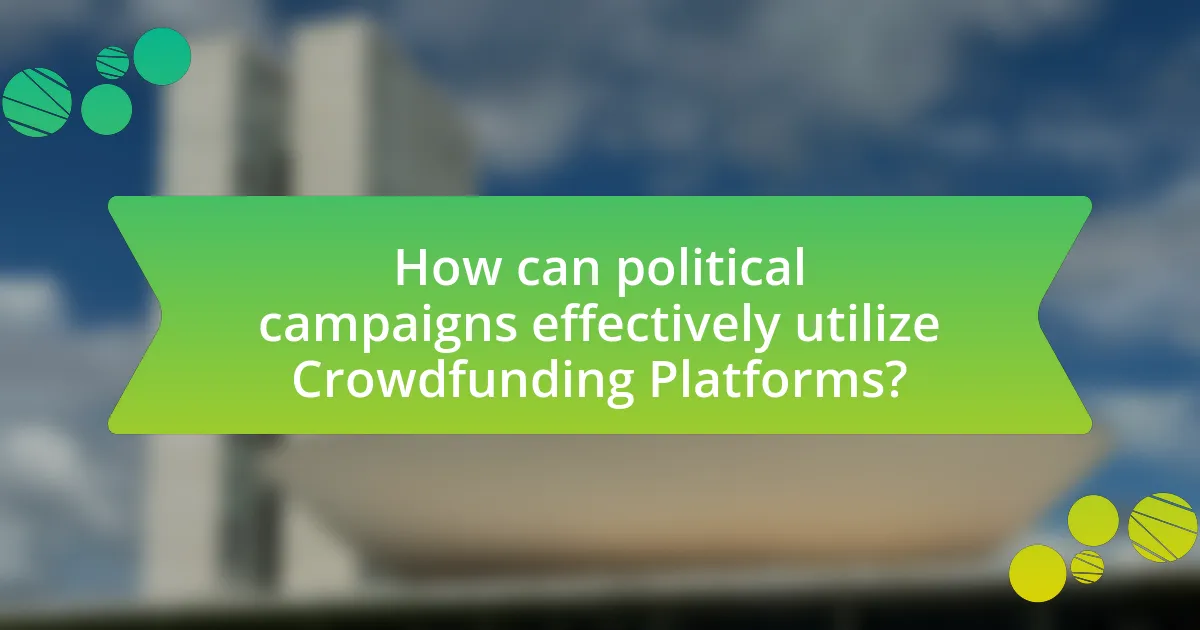
How can political campaigns effectively utilize Crowdfunding Platforms?
Political campaigns can effectively utilize crowdfunding platforms by creating engaging campaigns that resonate with potential donors and leveraging social media for outreach. Engaging campaigns often include clear messaging about the candidate’s vision, specific goals, and how contributions will be used, which can significantly increase donor interest. For instance, a study by the Pew Research Center found that 60% of Americans are more likely to donate to a campaign that shares personal stories and demonstrates transparency in fund allocation. Additionally, social media platforms can amplify the reach of crowdfunding efforts, as campaigns that actively promote their fundraising on platforms like Facebook and Twitter can tap into wider networks, leading to increased contributions. This combination of compelling narratives and strategic social media use has proven effective, as evidenced by the success of various political campaigns that have raised millions through crowdfunding.
What strategies can campaigns implement to maximize crowdfunding success?
Campaigns can maximize crowdfunding success by leveraging social media to engage potential donors and create a sense of community. Research indicates that campaigns utilizing social media platforms see a 30% increase in funding compared to those that do not actively engage online. Additionally, offering tiered rewards for different donation levels can incentivize contributions, as studies show that campaigns with structured reward systems raise 50% more on average. Furthermore, establishing a clear narrative around the campaign’s mission and goals enhances emotional connection, leading to higher donor retention rates.
How important is campaign storytelling in attracting donations?
Campaign storytelling is crucial in attracting donations, as it creates an emotional connection between the donor and the cause. Effective narratives engage potential donors by illustrating the impact of their contributions, making them feel part of a larger mission. Research indicates that campaigns with compelling stories can increase donations by up to 300%, demonstrating the power of storytelling in fundraising efforts. This connection not only motivates immediate giving but also fosters long-term relationships with donors, enhancing overall campaign success.
What role does social media play in promoting crowdfunding campaigns?
Social media plays a crucial role in promoting crowdfunding campaigns by facilitating widespread visibility and engagement. Platforms like Facebook, Twitter, and Instagram allow campaign creators to share their projects with a large audience, increasing the likelihood of attracting backers. According to a study by the University of Pennsylvania, campaigns that effectively utilize social media can raise up to 50% more funds than those that do not. This is largely due to the ability of social media to create a sense of community and urgency, encouraging users to share campaigns within their networks, thereby amplifying reach and potential contributions.
What best practices should campaigns follow when using crowdfunding platforms?
Campaigns should prioritize transparency, effective communication, and strategic marketing when using crowdfunding platforms. Transparency involves clearly outlining the campaign’s goals, budget, and how funds will be utilized, which builds trust with potential backers. Effective communication includes regular updates and engaging storytelling to maintain interest and encourage sharing among supporters. Strategic marketing entails leveraging social media and email campaigns to reach a broader audience, as studies show that campaigns with strong online presence can increase funding success by up to 50%. These best practices enhance credibility and maximize funding potential on crowdfunding platforms.
How can campaigns ensure compliance with legal regulations?
Campaigns can ensure compliance with legal regulations by implementing robust legal frameworks and adhering to established guidelines. This involves conducting thorough research on federal, state, and local laws governing political donations, including contribution limits and disclosure requirements. For instance, the Federal Election Commission mandates that campaigns report contributions exceeding $200, ensuring transparency and accountability. Additionally, campaigns should utilize compliance software to track donations and automate reporting processes, minimizing the risk of errors. Regular training for campaign staff on legal obligations further reinforces adherence to regulations, as evidenced by successful campaigns that have avoided legal pitfalls through diligent compliance efforts.
What methods can be used to maintain donor engagement post-campaign?
To maintain donor engagement post-campaign, organizations can implement personalized communication strategies, regular updates on project progress, and exclusive donor events. Personalized communication, such as tailored emails or messages, fosters a sense of connection and appreciation among donors. Regular updates on how their contributions are making an impact keep donors informed and invested in the cause. Exclusive donor events, whether virtual or in-person, provide opportunities for donors to engage directly with the organization and its mission, reinforcing their commitment. Research indicates that organizations that maintain consistent communication with donors see a 40% increase in donor retention rates, highlighting the effectiveness of these methods.
What are the future trends for Crowdfunding Platforms in Political Donations?
Future trends for crowdfunding platforms in political donations include increased regulatory scrutiny, the integration of blockchain technology for transparency, and the rise of micro-donations facilitated by mobile apps. Regulatory scrutiny is expected to intensify as governments seek to ensure compliance with campaign finance laws, which may lead to more stringent reporting requirements for platforms. Blockchain technology can enhance transparency and trust by providing immutable records of donations, thereby attracting more contributors concerned about the integrity of political funding. Additionally, the trend towards micro-donations, where small amounts are collected from a large number of supporters, is likely to grow, driven by the convenience of mobile payment solutions and social media engagement, as evidenced by the success of platforms like ActBlue in the U.S. that have capitalized on this model.
How might technology evolve to enhance crowdfunding for political purposes?
Technology might evolve to enhance crowdfunding for political purposes through the integration of blockchain for transparency and security. Blockchain technology can provide a decentralized ledger that ensures all transactions are traceable and immutable, thereby increasing trust among donors. Additionally, advancements in artificial intelligence can facilitate targeted outreach by analyzing donor behavior and preferences, allowing campaigns to tailor their messaging effectively. Furthermore, the use of mobile applications can streamline the donation process, making it more accessible and user-friendly, which can lead to increased participation. These technological advancements can significantly improve the efficiency and reliability of crowdfunding in political contexts.
What impact will changing voter demographics have on crowdfunding strategies?
Changing voter demographics will significantly influence crowdfunding strategies by necessitating tailored approaches that resonate with diverse groups. As the electorate becomes more varied in age, ethnicity, and socioeconomic status, crowdfunding campaigns must adapt their messaging and outreach methods to engage these new voter segments effectively. For instance, younger voters, who are increasingly active in online fundraising, may respond better to digital engagement strategies, while older demographics might prefer traditional communication methods. Research from the Pew Research Center indicates that younger voters are more likely to support candidates who utilize social media and online platforms for fundraising, highlighting the need for campaigns to leverage these tools to maximize contributions. Additionally, understanding the values and priorities of different demographic groups can help campaigns craft specific narratives that align with their interests, thereby enhancing the effectiveness of crowdfunding efforts.
What practical tips can campaigns follow to succeed with Crowdfunding Platforms?
Campaigns can succeed with crowdfunding platforms by clearly defining their goals and effectively communicating their message. Establishing a specific funding target helps potential backers understand the campaign’s needs, while a compelling narrative engages supporters emotionally. Additionally, leveraging social media to promote the campaign can significantly increase visibility; studies show that campaigns with strong social media presence raise 50% more funds. Regular updates to backers maintain engagement and build trust, which is crucial for ongoing support. Lastly, offering attractive rewards or incentives can motivate contributions, as campaigns that provide tangible benefits often see higher funding success rates.



